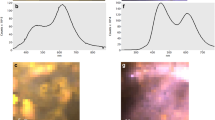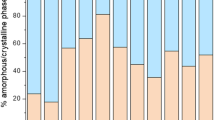Abstract
BY infra-red absorption analysis, it is possible to make a semi-quantitative estimation of the kaolin minerals. In contrast to X-ray diffraction, the infrared spectrum of halloysite is as clearly defined as those of kaolinite and dickite, and the content of these three minerals in mixtures can be determined by a ratio between the depths of their hydroxyl absorptions. The peaks at 2.70µ (A) and 2.75µ (B) are common to all three minerals, and a peak depth ratio A/B of 1.2–1.5 is characteristic of kaolinite, with a ratio A/B of 0.8–0.9 characterizing halloysite. Values of 0.6–0.8 are typical of dickite. If the depth of the band due to physically adsorbed water at 2.9µ (C) is plotted as the abscissa with A/B as the ordinate, the three minerals fall into separate areas.
This is a preview of subscription content, access via your institution
Access options
Subscribe to this journal
Receive 51 print issues and online access
$199.00 per year
only $3.90 per issue
Buy this article
- Purchase on Springer Link
- Instant access to full article PDF
Prices may be subject to local taxes which are calculated during checkout
Similar content being viewed by others
References
Bates, T., and Comer, J. J., Clays and Clay Minerals, Proc. Sixth Nat. Clay Conf., Nat. Acad. Sci.–Nat. Res. Council (1958).
Tuddenham, W. M., and Lyon, R. J. P., Anal. Chem., 31, 377 (1959).
Author information
Authors and Affiliations
Rights and permissions
About this article
Cite this article
LYON, R., TUDDENHAM, W. Infra-Red Determination of the Kaolin Group Minerals. Nature 185, 835–836 (1960). https://doi.org/10.1038/185835a0
Issue Date:
DOI: https://doi.org/10.1038/185835a0
This article is cited by
-
Kaolinisation of granite in an urban environment
Environmental Geology (2007)
-
Kaolinite-genetic and thermoanalytical parameters
Journal of Thermal Analysis (1997)
-
Physico-chemical behaviour of hydrated aluminium oxides and associated clay minerals occurring around Pipra, district Sidhi, India
Journal of Thermal Analysis (1979)
-
O-H stretching vibrations in kaolinite, and related minerals
Contributions to Mineralogy and Petrology (1969)
Comments
By submitting a comment you agree to abide by our Terms and Community Guidelines. If you find something abusive or that does not comply with our terms or guidelines please flag it as inappropriate.



